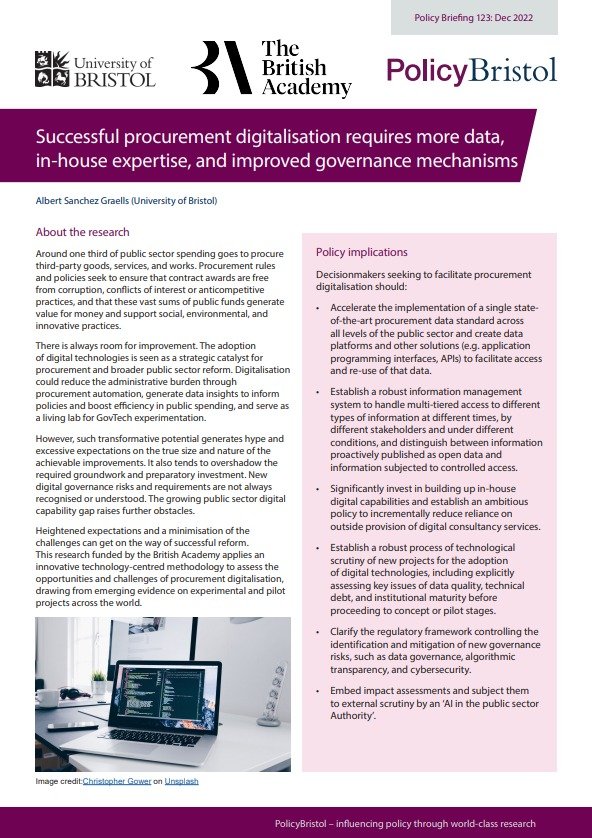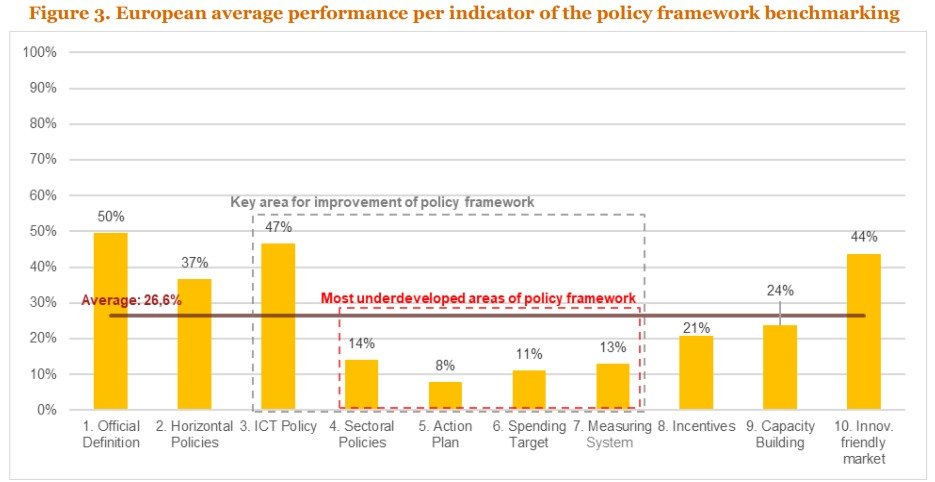In the current context of generalised quick adoption of digital technologies across the public sector and strategic steers to accelerate the digitalisation of public procurement, decision-makers can be captured by techno hype and the ‘policy irresistibility’ that can ensue from it (as discussed in detail here, as well as here).
To moderate those pressures and guide experimentation towards the successful deployment of digital solutions, decision-makers must reassess the realistic potential of those technologies in the specific context of procurement governance. They must also consider which enabling factors must be put in place to harness the potential of the digital technologies—which primarily relate to an enabling big data architecture (see here). Combined, the data requirements and the contextualised potential of the technologies will help decision-makers draw a feasibility boundary for digital procurement governance, which should inform their decisions.
In a new draft chapter (num 7) for my book project, I draw such a technology-informed feasibility boundary for digital procurement governance. This post provides a summary of my main findings, on which I will welcome any comments: a.sanchez-graells@bristol.ac.uk. The full draft chapter is free to download: A Sanchez-Graells, ‘Revisiting the promise: A feasibility boundary for digital procurement governance’ to be included in A Sanchez-Graells, Digital Technologies and Public Procurement. Gatekeeping and experimentation in digital public governance (OUP, forthcoming). Available at SSRN: https://ssrn.com/abstract=4232973.
Data as the main constraint
It will hardly be surprising to stress again that high quality big data is a pre-requisite for the development and deployment of digital technologies. All digital technologies of potential adoption in procurement governance are data-dependent. Therefore, without adequate data, there is no prospect of successful adoption of the technologies. The difficulties in generating an enabling procurement data architecture are detailed here.
Moreover, new data rules only regulate the capture of data for the future. This means that it will take time for big data to accumulate. Accessing historical data would be a way of building up (big) data and speeding up the development of digital solutions. Moreover, in some contexts, such as in relation with very infrequent types of procurement, or in relation to decisions concerning previous investments and acquisitions, historical data will be particularly relevant (eg to deploy green policies seeking to extend the use life of current assets through programmes of enhanced maintenance or refurbishment; see here). However, there are significant challenges linked to the creation of backward-looking digital databases, not only relating to the cost of digitisation of the information, but also to technical difficulties in ensuring the representativity and adequate labelling of pre-existing information.
An additional issue to consider is that a number of governance-relevant insights can only be extracted from a combination of procurement and other types of data. This can include sources of data on potential conflict of interest (eg family relations, or financial circumstances of individuals involved in decision-making), information on corporate activities and offerings, including detailed information on products, services and means of production (eg in relation with licensing or testing schemes), or information on levels of utilisation of public contracts and satisfaction with the outcomes by those meant to benefit from their implementation (eg users of a public service, or ‘internal’ users within the public administration).
To the extent that the outside sources of information are not digitised, or not in a way that is (easily) compatible or linkable with procurement information, some data-based procurement governance solutions will remain undeliverable. Some developments in digital procurement governance will thus be determined by progress in other policy areas. While there are initiatives to promote the availability of data in those settings (eg the EU’s Data Governance Act, the Guidelines on private sector data sharing, or the Open Data Directive), the voluntariness of many of those mechanisms raises important questions on the likely availability of data required to develop digital solutions.
Overall, there is no guarantee that the data required for the development of some (advanced) digital solutions will be available. A careful analysis of data requirements must thus be a point of concentration for any decision-maker from the very early stages of considering digitalisation projects.
Revised potential of selected digital technologies
Once (or rather, if) that major data hurdle is cleared, the possibilities realistically brought by the functionality of digital technologies need to be embedded in the procurement governance context, which results in the following feasibility boundary for the adoption of those technologies.
Robotic Process Automation (RPA)
RPA can reduce the administrative costs of managing pre-existing digitised and highly structured information in the context of entirely standardised and repetitive phases of the procurement process. RPA can reduce the time invested in gathering and cross-checking information and can thus serve as a basic element of decision-making support. However, RPA cannot increase the volume and type of information being considered (other than in cases where some available information was not being taken into consideration due to eg administrative capacity constraints), and it can hardly be successfully deployed in relation to open-ended or potentially contradictory information points. RPA will also not change or improve the processes themselves (unless they are redesigned with a view to deploying RPA).
This generates a clear feasibility boundary for RPA deployment, which will generally have as its purpose the optimisation of the time available to the procurement workforce to engage in information analysis rather than information sourcing and basic checks. While this can clearly bring operational advantages, it will hardly transform procurement governance.
Machine Learning (ML)
Developing ML solutions will pose major challenges, not only in relation to the underlying data architecture (as above), but also in relation to specific regulatory and governance requirements specific to public procurement. Where the operational management of procurement does not diverge from the equivalent function in the (less regulated) private sector, it will be possible to see the adoption or adaptation of similar ML solutions (eg in relation to category spend management). However, where there are regulatory constraints on the conduct of procurement, the development of ML solutions will be challenging.
For example, the need to ensure the openness and technical neutrality of procurement procedures will limit the possibilities of developing recommender systems other than in pre-procured closed lists or environments based on framework agreements or dynamic purchasing systems underpinned by electronic catalogues. Similarly, the intended use of the recommender system may raise significant legal issues concerning eg the exercise of discretion, which can limit their deployment to areas of information exchange or to merely suggestion-based tasks that could hardly replace current processes and procedures. Given the limited utility (or acceptability) of collective filtering recommender solutions (which is the predominant type in consumer-facing private sector uses, such as Netflix or Amazon), there are also constraints on the generality of content-based recommender systems for procurement applications, both at tenderer and at product/service level. This raises a further feasibility issue, as the functional need to develop a multiplicity of different recommenders not only reopens the issue of data sufficiency and adequacy, but also raises questions of (economic and technical) viability. Recommender systems would mostly only be susceptible of feasible adoption in highly centralised procurement settings. This could create a push for further procurement centralisation that is not neutral from a governance perspective, and that can certainly generate significant competition issues of a similar nature, but perhaps a different order of magnitude, than procurement centralisation in a less digitally advanced setting. This should be carefully considered, as the knock-on effects of the implementation of some ML solutions may only emerge down the line.
Similarly, the development and deployment of chatbots is constrained by specific regulatory issues, such as the need to deploy closed domain chatbots (as opposed to open domain chatbots, ie chatbots connected to the Internet, such as virtual assistants built into smartphones), so that the information they draw from can be controlled and quality assured in line with duties of good administration and other legal requirements concerning the provision of information within tender procedures. Chatbots are suited to types of high-volume information-based queries only. They would have limited applicability in relation to the specific characteristics of any given procurement procedure, as preparing the specific information to be used by the chatbot would be a challenge—with the added functionality of the chatbot being marginal. Chatbots could facilitate access to pre-existing and curated simple information, but their functionality would quickly hit a ceiling as the complexity of the information progressed. Chatbots would only be able to perform at a higher level if they were plugged to a knowledge base created as an expert system. But then, again, in that case their added functionality would be marginal. Ultimately, the practical space for the development of chatbots is limited to low added value information access tasks. Again, while this can clearly bring operational advantages, it will hardly transform procurement governance.
ML could facilitate the development and deployment of ‘advanced’ automated screens, or red flags, which could identify patterns of suspicious behaviour to then be assessed against the applicable rules (eg administrative and criminal law in case of corruption, or competition law, potentially including criminal law, in case of bid rigging) or policies (eg in relation to policy requirements to comply with specific targets in relation to a broad variety of goals). The trade off in this type of implementation is between the potential (accuracy) of the algorithmic screening and legal requirements on the explainability of decision-making (as discussed in detail here). Where the screens were not used solely for policy analysis, but acting on the red flag carried legal consequences (eg fines, or even criminal sanctions), the suitability of specific types of ML solutions (eg unsupervised learning solutions tantamount to a ‘black box’) would be doubtful, challenging, or altogether excluded. In any case, the development of ML screens capable of significantly improving over RPA-based automation of current screens is particularly dependent on the existence of adequate data, which is still proving an insurmountable hurdle in many an intended implementation (as above).
Distributed ledger technology (DLT) systems and smart contracts
Other procurement governance constraints limit the prospects of wholesale adoption of DLT (or blockchain) technologies, other than for relatively limited information management purposes. The public sector can hardly be expected to adopt DLT solutions that are not heavily permissioned, and that do not include significant safeguards to protect sensitive, commercially valuable, and other types of information that cannot be simply put in the public domain. This means that the public sector is only likely to implement highly centralised DLT solutions, with the public sector granting permissions to access and amend the relevant information. While this can still generate some (degrees of) tamper-evidence and permanence of the information management system, the net advantage is likely to be modest when compared to other types of secure information management systems. This can have an important bearing on decisions whether DLT solutions meet cost effectiveness or similar criteria of value for money controlling their piloting and deployment.
The value proposition of DLT solutions could increase if they enabled significant procurement automation through smart contracts. However, there are massive challenges in translating procurement procedures to a strict ‘if/when ... then’ programmable logic, smart contracts have limited capability that is not commensurate with the volumes and complexity of procurement information, and their development would only be justified in contexts where a given smart contract (ie specific programme) could be used in a high number of procurement procedures. This limits its scope of applicability to standardised and simple procurement exercises, which creates a functional overlap with some RPA solutions. Even in those settings, smart contracts would pose structural problems in terms of their irrevocability or automaticity. Moreover, they would be unable to generate off-chain effects, and this would not be easily sorted out even with the inclusion of internet of things (IoT) solutions or software oracles. This comes to largely restrict smart contracts to an information exchange mechanism, which does not significantly increase the value added by DLT plus smart contract solutions for procurement governance.
Conclusion
To conclude, there are significant and difficult to solve hurdles in generating an enabling data architecture, especially for digital technologies that require multiple sources of information or data points regarding several phases of the procurement process. Moreover, the realistic potential of most technologies primarily concerns the automation of tasks not involving data analysis of the exercise of procurement discretion, but rather relatively simple information cross-checks or exchanges. Linking back to the discussion in the earlier broader chapter (see here), the analysis above shows that a feasibility boundary emerges whereby the adoption of digital technologies for procurement governance can make contributions in relation to its information intensity, but not easily in relation to its information complexity, at least not in the short to medium term and not in the absence of a significant improvement of the required enabling data architecture. Perhaps in more direct terms, in the absence of a significant expansion in the collection and curation of data, digital technologies can allow procurement governance to do more of the same or to do it quicker, but it cannot enable better procurement driven by data insights, except in relatively narrow settings. Such settings are characterised by centralisation. Therefore, the deployment of digital technologies can be a further source of pressure towards procurement centralisation, which is not a neutral development in governance terms.
This feasibility boundary should be taken into account in considering potential use cases, as well as serve to moderate the expectations that come with the technologies and that can fuel ‘policy irresistibility’. Further, it should be stressed that those potential advantages do not come without their own additional complexities in terms of new governance risks (eg data and data systems integrity, cybersecurity, skills gaps) and requirements for their mitigation. These will be explored in the next stage of my research project.













